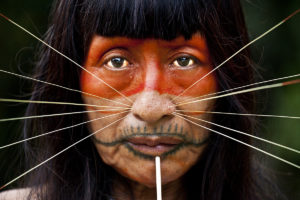
Many Matsés no longer tattoo their faces or wear tribal adornments like these whiskers. ©Alicia Fox Photography
Photography has been described as the art of frozen time, the ability to store emotions and feelings within a single frame. It freezes time, capturing a slice of existence that may never be repeated again, and records that moment in life’s fleeting light.
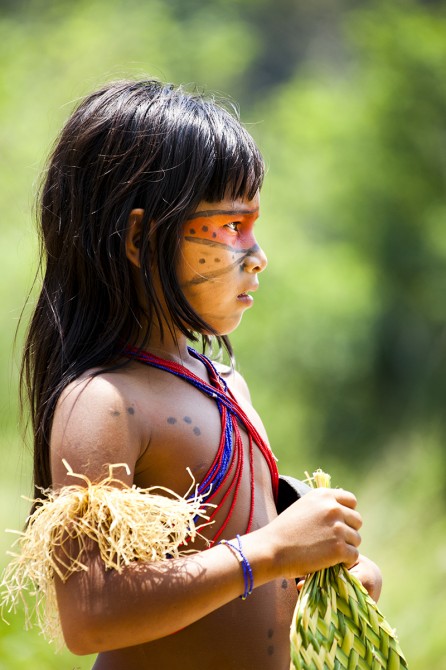
Young Matsés girl in traditional dress ©Alicia Fox Photography
I had the pleasure of meeting Alicia Fox while volunteering for Eco-Ola in Mazán, Perú. Alicia was traveling with her partner, James, throughout Central and South America, at the tail end of a three-year journey, documenting the work of sustainable organizations as well as the indigenous peoples they met along the way.
They arrived in Mazán to document the large-scale sustainable agriculture project Eco-Ola is undertaking. Alicia was kind, professional, and quick with her camera. I was busy working with daily farm tasks, and wasn’t able to shadow them as they toured the farm, but when I finally saw the photos from her shoot, I was impressed at how accurately she captured the unique personalities of each worker.
Portraits of the Matsés
It wasn’t until recently that I discovered that Alicia traveled to Matsés territory and visited the villages of Buen and Remoyacu deep in remote interior of the Peruvian Amazon. I quickly followed up with Alicia congratulating her on the stunning photography I had seen on her website, and asked if we could do an interview to share her experiences on Matsés life to our readers and supporters.
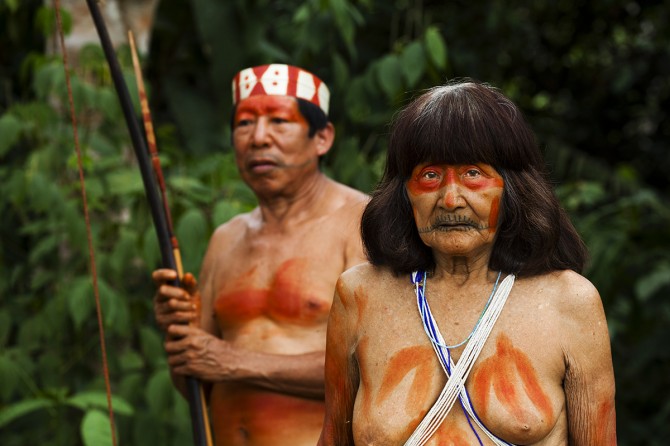
Matsés elder and his wife © Alicia Fox Photography
Alicia kindly accepted and also graciously offered to share her beautiful, and powerful portraits with us. As turned out, her trip into Matsés territory proved the most challenging of her travels in Latin America. We hope you enjoy the portraits of the Matsés and Alicia’s perspective, windows onto a remarkable people struggling to maintain their cultural identity and presence against the sweeping currents of modern assimilation.
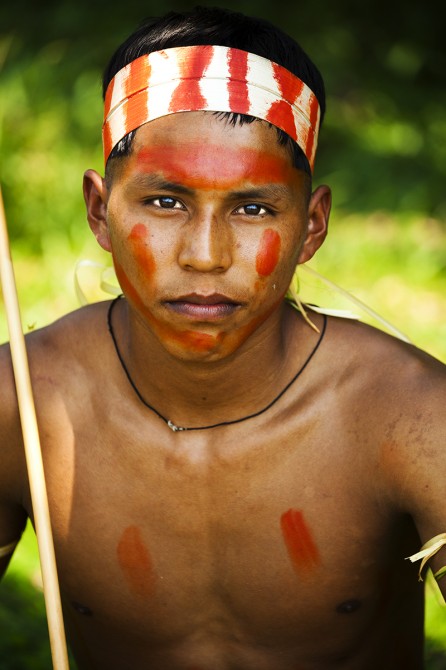
Matsés youth in traditional face paint and dress ©Alicia Fox Photography
As a documentary photographer, you recently visited tribes in the Peruvian Amazon, including the Matsés. What initially drew you to this region?
I was nearing the end of three years traveling through South and Central America, where I had really pushed myself to explore the edges of what I thought was “normal” and my familiar way of life, and my encounters with indigenous groups were the most inspiring and memorable parts of the journey. I find their connection and understanding of nature to be so beautiful, and I wanted to discover more about their cultures, and share what I found with others, through images.
I had learnt that there were tribes in the Amazon which had had little contact with the outside world, and others which were well on their way towards modernized living. Each tribe faces ongoing threats including war, logging, disease, land acquisition, and industrial contamination of water sources. These threats seem to be contributing to the disappearance of the traditional way of life of most tribes. The more I researched this, the more compelled I felt to make photographs of these disappearing tribes in a way that would best record traditional tribal identities.
All of your photos feature the indigenous people in traditional dress. What was the process for preparing your subjects for the photos? Did you photograph them in their day-to-day clothing and activities?
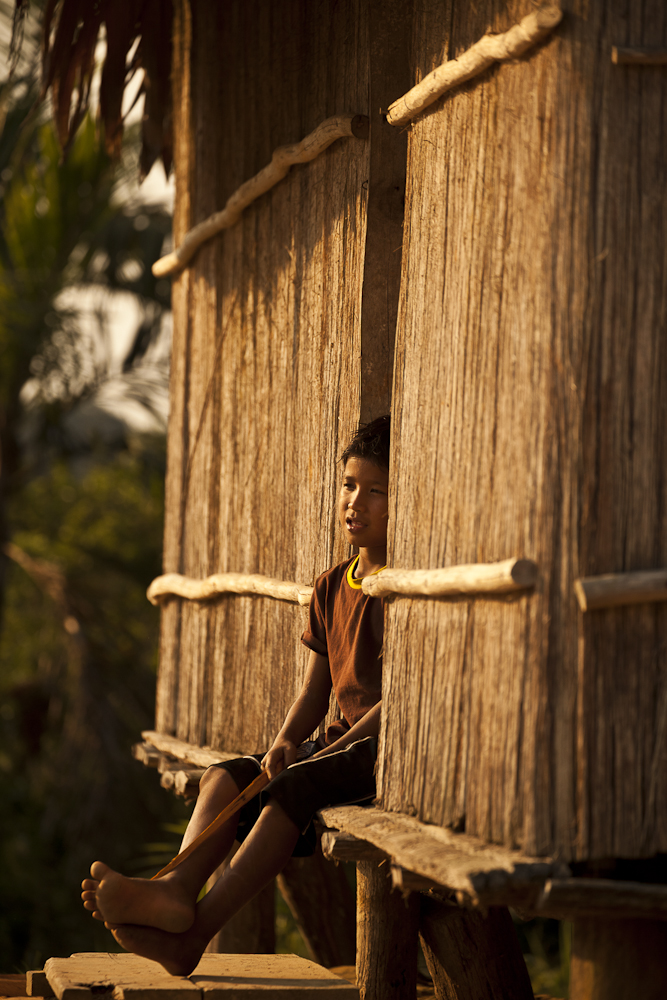
Matsés boy sitting in his traditional palm thatch hut ©Alicia Fox Photography
Once I had gained the chief’s trust, he would then organize people to be in the photographs, either that day or in the days that followed. Some of them wore traditional clothing on a daily basis, others wore it only for special occasions. I knew I was in a very rare and fortunate position, to have gained access into the personal and sacred lives of these rarely seen communities.
The most remote village James and I visited was in the Ashaninka region, and we did so with NGOs Cool Earth and Eco Tribal. The photographic process was different in this situation, as I was documenting the Ashaninka for the organizations. By being introduced by people who tribal members knew and trusted, I was able to move around more freely and make more candid photographs. People in this village had been visited by outsiders only 3 times in the previous decade, so it was an honor to be welcomed into their village and an amazing privilege to be able to photograph them.
At other times, encountering a tribe required us to follow a series of leads to different people with connections, and at other times it took a series of canoe trips up river exploring the jungle physically, in search of a possible village.
As my project was to photograph portraits representing the traditional way of life, I didn’t make many photos of tribal members who were wearing modern clothing.
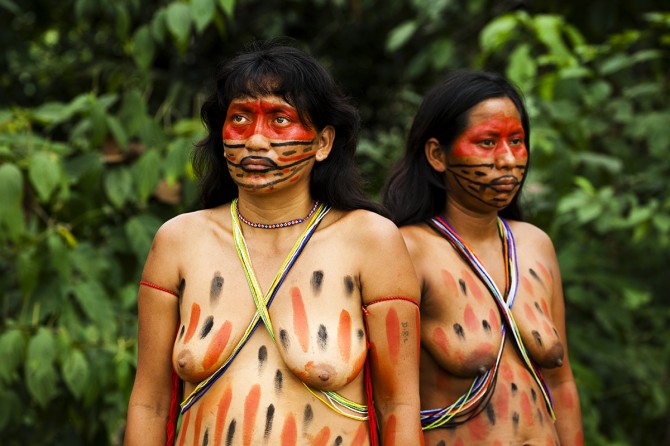
Two Matsés women in traditional dress and body paint Alicia Fox Photography
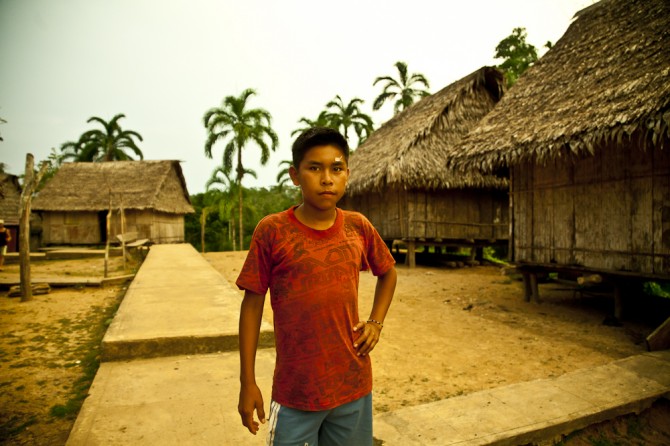
A Matsés youth, wearing modern attire, in the village of Buen ©Alicia Fox Photography
What were the moods of the people during the prep and photo shoots? How did the tribal members respond/feel to being photographed in traditional clothing (or being photographed in general)?
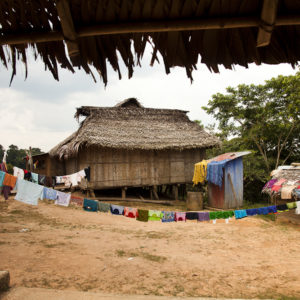
View of Matsés village Alicia Fox Photography
There was a fine line between me taking the time to capture beautiful photos, and taking too long and making them feel uncomfortable. I didn’t want to overstep that, because it’s important to me that each person has a positive experience.
I loved showing the image on the back of the camera as this always gained a strong response: mostly laugher but sometimes pure amazement, followed by requests for more photos.
How was the mood and tone of the shoots between the different tribes?
Tribes closer to Iquitos, including the Bora and Yagua, are more accustomed to having tourists visit, which made the process simpler for me, however it felt a little staged. In the more remote areas, the interaction felt more sincere. The people were as inquisitive about my camera and me as I was about them, which created a pleasant balance. In these circumstances it was really helpful to have the assistance of someone like the chief, a local authority or an anthropologist, to help foster trust towards me.
The only time where some people refused to have their photos taken was when I visited the Matsés. There, I sensed a lot of skepticism towards outsiders.
We, at Acaté, work directly with the Matsés people in the Peruvian Amazon. Which Matsés villages specifically did you go?
James and I firstly arrived in Angamos, and then with permission from the chief, visited the villages of Buen Perú and Remoyacu.
I read that your entry into the Matsés area was challenging and took a lot of negotiating, what was the vetting process like? What were the reasons and rationale by the tribe or chief for vetting you?
Yes, the Matsés region was the most challenging to travel around, as it was the only place we came across official travel restrictions. I understand that the vetting process came about as a way to protect the Matsés, following past negative experiences with outsiders. Before arriving to Angamos, the main town (i.e. large village) in the Matsés region, we visited the SENANP office in Iquitos, to find out what we needed to do to get in contact with the tribes. We were given the email address of the chief and a phone number of the village phone, but weren’t able to reach him on either.
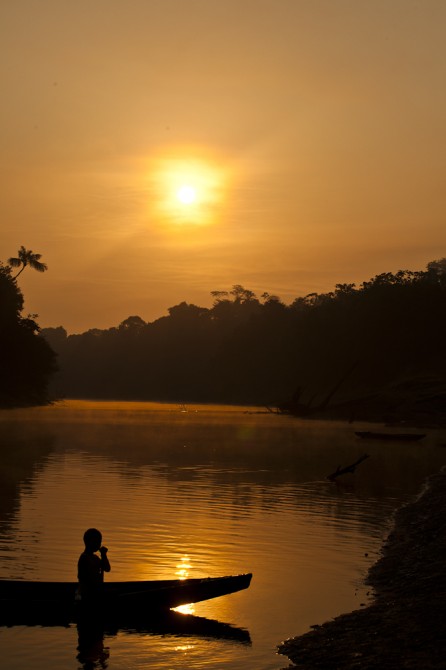
Sunset over Amazon quebrada in Matsés territory Alicia Fox Photography
So we took our chances and travelled to Angamos, by military plane. In Angamos we needed the chief’s permission to go any further. It took a few days waiting before we were able to meet up with the chief, and he was reluctant to let us visit any of the villages. With persistence we were allowed to visit one village as it was already hosting a presentation for government officials from Lima, which coincided with the anniversary of the Matsés first contact with the outside world.
We spent one day and night at Buen, Peru, and were fortunate to meet a man there who offered to take us to his village of Remoyaco, where I would find the women with spines in their noses and facial tattoos. The chief granted us permission to continue upstream.
On arrival in Remoyacu we met with the village chief who informed us that before we were allowed to do anything in the village, we were required to attend a village meeting, where we would explain why we were there and seek permission to walk around the village and take photographs. Although this was quite intimidating, I respect this formality and the tribe’s efforts to protect their interests.
How long were you able to stay with the Matsés? What experiences particularly stand out from your time there?
The flights in and out of Angamos occurred weekly, and being unsure as to whether we would be allowed to make any contact with the tribal members I was hoping to photograph, we booked a plane ticket out one week after our arrival, allowing just 7 days to gain permission and travel to the villages. It took days to gain permission and locate a boat with enough fuel for the journey (as it was dry season and transporting fuel was difficult) so we had just 3 nights in the Buen Peru and Remoyacu.

Matsés girls enjoying Alicia’s attention Alicia Fox Photography
The whole experience in the villages was memorable. We arrived to Remoyacu after hours of traveling up river in the dark, through waters so shallow that we ran into the occasional log or sandbank. We were welcomed by a lovely family who served us a fish, yucca and a drink made from plantain, which we ate and drank sitting on the floor of their palm thatch hut.
The Matsés had fascinated me ever since I first saw a photograph of a woman with spines in her nose and face tattoos. Meeting some of these women who still wear the spines, even while sleeping in a hammock, was a very special experience. We are in a very important point in history when tribes throughout the world are disappearing on a weekly basis, so I feel so privileged to meet people who are still living traditional tribal lives.
What was you impression of the day-to-day activities of the people?
From what I saw, the day to do activities of the Matsés were typical of tribes throughout the Amazon. The men fish, hunt and repair huts. The women prepare food, wash clothing in the river, clean the home and look after children. Children go to school and play outdoors. The lifestyle is slow paced and purposeful.
What impression did you get regarding their life and the challenges they face? Did you feel or see any evidence of malnutrition or was the tribe being adequately nourished?
I got the impression that the villages I visited are in the midst of a challenging transition, from a traditional way of life towards becoming part of the modern world. As villagers become aware of the outside world through television, the internet and by visiting other areas, they have natural desire to have and experience things they encounter, which creates the need for a currency which wasn’t as necessary in the past.
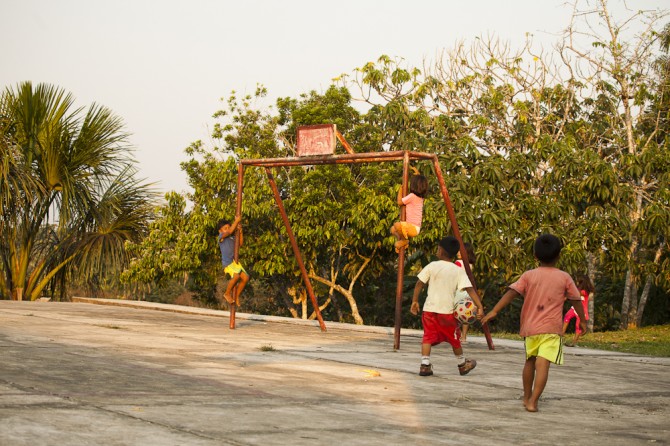
Matsés children playing on goal posts Alicia Fox Photography

Matsés young girl playing on plastic dish in the river Alicia Fox Photography
I didn’t witnesses evidence of malnutrition during my short stay, however the diet seemed quite limited. Our host family ate smoked fish, yucca and banana for most meals. As a modern diet including junk food and artificial drinks becomes increasingly popular in the villages, the level of health will no doubt suffer.
What were the marks of modern society that you observed? Did you see brands and plastics?
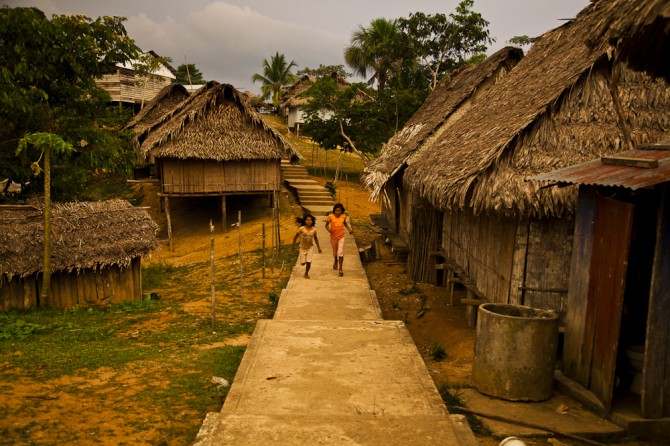
Matsés village pathways alongside Matsés huts Alicia Fox Photography
After traveling so far into the jungle to arrive at the villages I was surprised to see satellites and electrical wiring, although I never saw either put to use. There were some bessa-block [concrete-block] community buildings, however all the homes were huts made from natural materials.
People seemed to be quite reliant on petroleum to get around by boat, which is relatively expensive considering the local income. And of course, there was the modern clothing that the majority of people were wearing.
I saw plastic scattered along the ground, and I understand that people are so accustomed to natural materials that break down, and it is a new concept to have to deal with products that don’t decompose.
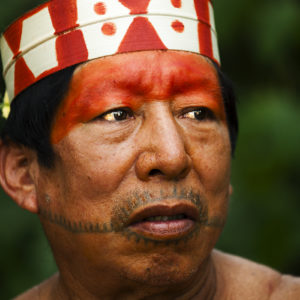
Portrait of Matsés elder ©2013 Alicia Fox Photography
You have some familiarity with permaculture. What do you think the practice of permaculture holds for people like the Matsés?
Many of the places we visited were very much in need of (or looking for) support from the government and the outside. I see Permaculture as holding great promise to be a tool to re-establish self-reliance and a means to integrate their extensive traditional knowledge system with outside knowledge and skills. It may be a way for them to reinvent their lives and move forward without losing the old ways.
For an isolated group like the Matsés, it holds the short term promise of providing nutritious food without the cost of transporting from another area.
Did anyone express to you their perspectives regarding how their cultures are being impacted by external influences?
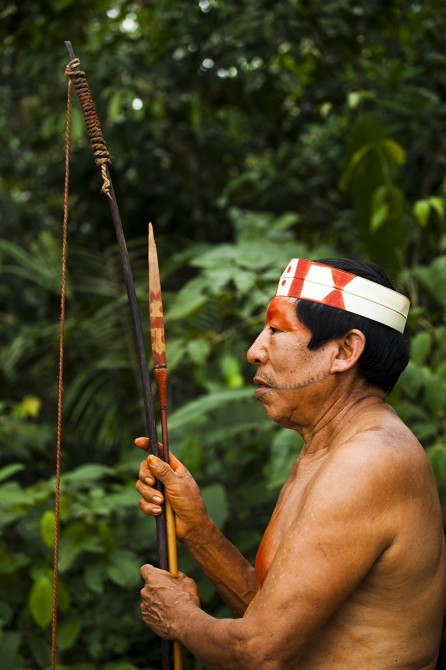
Matsés elder with traditional hunting bow and arrow Alicia Fox Photography
Andres, our host and guide, told us that 8 years ago the Matsés became “civilized” as a result of villagers converting to Christianity. He said this included them stopping the practice of cannibalism at that time (although I am still not sure how much truth is in that).
I sensed a lot of angst towards outsiders and was told by members of the tribe that this is due to negative experiences with past visitors to the Matsés region. These include a carbon project scam conducted by an Australian man, and a UK reality TV show production. I felt that the Matsés trust has been heavily betrayed and as a result they were more skeptical of us than any other tribe we’d visited.
Did the tribal leaders have anything to say or pass on to those living outside of the Amazon rainforest?
The leaders didn’t ask me to pass on any message, however through the presentation to the government officials during El Anniversario Contacto Matsés, the Matsés leaders sent a crystal clear message that they are a people who do not want to be viewed as terrorists or savages. They also asked for the governments help regarding education, health and communication, saying that they are part of Peru and shouldn’t be forgotten just because they are far away from Lima.
We’d like to thank Alicia for taking the time to answer our questions and help better illustrate the present-day situation on the ground for the Matsés people and other indigenous tribes like them.
All photos copyright Alicia Fox Photography and used with permission.
